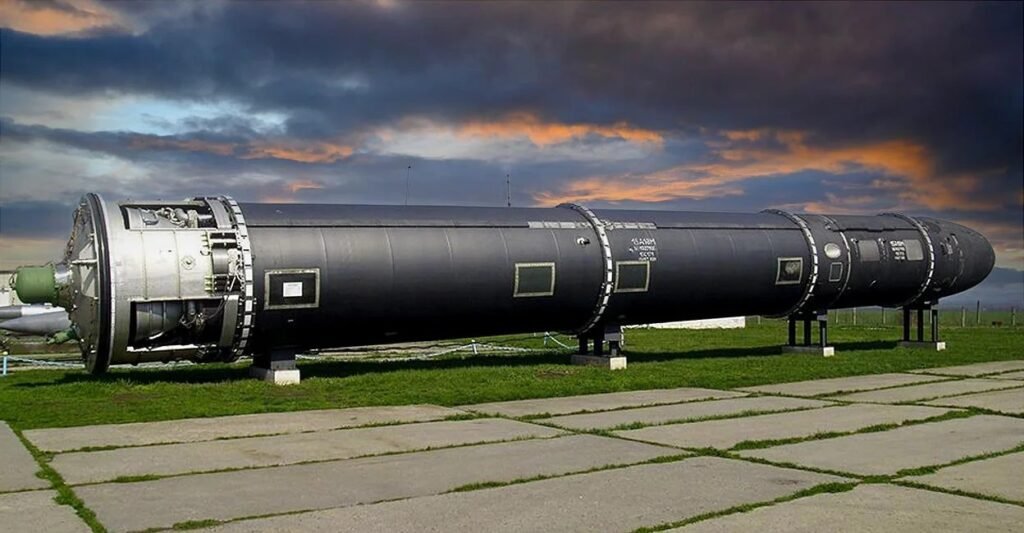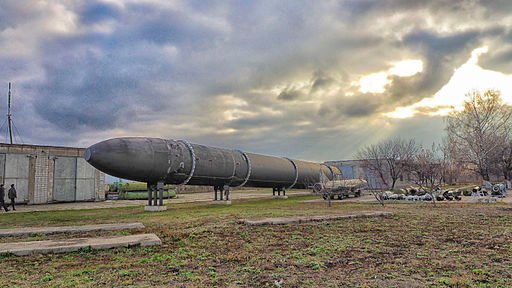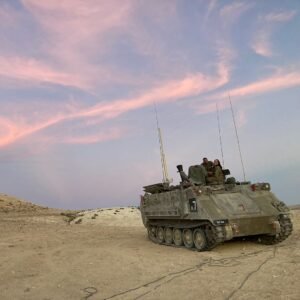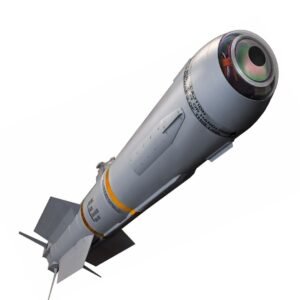An in-depth look at the Unmatched Range, Power, & Precision of Russia’s Newest ICBM
I. Introduction:
The RS-28 Sarmat ICBM, also known as the SS-X-30 or Satan 2, is one of the most powerful intercontinental ballistic missiles in the world. It has been developed by Russia to replace the aging RS-36M Voyevoda (SS-18 Satan) missile.

II. Capabilities of The RS-28 Sarmat ICBM:
The RS-28 Sarmat ICBM is a heavy missile that is capable of carrying up to 10 heavy warheads or 16 lighter ones. It has a range of up to 18,000 kilometers, making it capable of reaching targets across the globe. The missile is highly maneuverable and is equipped with advanced countermeasures that make it difficult to intercept. It is also capable of traveling at hypersonic speeds, making it virtually impossible to defend against.
The RS-28 Sarmat Missile is designed to be highly accurate, with a circular error probable (CEP) of less than 10 meters. This means that it can strike targets with a high degree of precision, making it an effective weapon for both offensive and defensive purposes.
III. Development of The RS-28 Sarmat ICBM:
The RS 28 Sarmat ICBM has been in development since the early 2010s and has undergone several tests over the years. The missile was first tested in 2018, and it is expected to enter service with the Russian military in the near future.
The development of the RS-28 Sarmat has been a challenging process due to the missile’s size and weight. The missile is over 35 meters long and weighs over 200 tons, making it one of the largest and heaviest missiles in the world. The missile’s design and engineering have had to take into account these factors while also ensuring that the missile is highly maneuverable and accurate.

IV. Strategic Importance of The RS-28 Sarmat ICBM:
The RS-28 Sarmat Missile is an important part of Russia’s nuclear deterrence strategy. The missile is seen as a key element in Russia’s ability to retaliate in the event of a nuclear attack. The missile’s range and accuracy make it an effective weapon for both offensive and defensive purposes. It’s allowing Russia to strike at a potential enemy’s nuclear arsenal while also defending its own.
The RS-28 Sarmat ICBM’s advanced capabilities also have strategic implications for the global power balance. The missile’s ability to evade and overcome missile defense systems makes it a significant challenge for countries that rely on missile defense systems to protect against potential nuclear threats.
V. Possible Scenarios for Use in a Military Conflict:
The RS-28 Sarmat ICBM’s potential use in a military conflict is a significant concern for the international community. In the event of a conflict, the missile’s range and accuracy could be used to strike at a potential enemy’s strategic targets, including military bases, command centers, and other critical infrastructure.
However, the use of the RS-28 Sarmat missile in a military conflict would have significant consequences for international security and stability. The use of nuclear weapons could trigger a catastrophic chain reaction, leading to widespread devastation and loss of life.

VI. RS-28 Sarmat Variants
The RS-28 Sarmat ICBM, also known as the SS-X-30 or Satan 2, has undergone several variants and tests over the years. Here is a brief overview of the different models and their testing history:
- RS-28 Sarmat Model 1 (2018): The first model of the RS-28 Sarmat was tested in 2018. This missile is designed to replace the aging RS-36M Voyevoda (SS-18 Satan) missile, which has been in service since the 1970s. The RS-28 Sarmat Model 1 has a range of up to 18,000 kilometers and can carry up to 10 heavy warheads or 16 lighter ones.
- RS-28 Sarmat Model 2 (2020): The second model of the RS-28 Sarmat ICBM was tested in 2020. This model is equipped with advanced countermeasures that make it difficult to intercept. It is also capable of traveling at hypersonic speeds, making it virtually impossible to defend against. The missile’s accuracy has also been improved, with a circular error probable (CEP) of less than 10 meters.
- RS-28 Sarmat Model 3 (2022): The third model of the RS-28 Sarmat ICBM was tested in 2022. This model is equipped with improved propulsion systems that allow it to travel at even higher speeds than the previous models. It is also designed to be more maneuverable, making it even more difficult to intercept.
VII. Testing History:
The development of the RS-28 Sarmat Missile has been ongoing since the early 2010s, with several tests being conducted over the years. The missile’s testing history includes:
- First Test (2018): The RS-28 Sarmat Missile was first tested in March 2018. The missile was launched from the Plesetsk Cosmodrome in northern Russia and successfully hit its target at the Kura range in the far east of the country.
- Second Test (2019): The second test of the RS 28 Sarmat ICBM was conducted in December 2019. This test was intended to confirm the missile’s range and accuracy. The missile was launched from the Plesetsk Cosmodrome and traveled over 5,000 kilometers before hitting its target at the Kura range.
- Third Test (2020): The third test of the RS 28 Sarmat ICBM was conducted in September 2020. This test was intended to demonstrate the missile’s advanced countermeasures and hypersonic capabilities. The missile was launched from the Plesetsk Cosmodrome and successfully evaded missile defense systems before hitting its target at the Kura range.
- Fourth Test (2022): The fourth test of the RS 28 Sarmat ICBM was conducted in February 2022. This test was intended to demonstrate the missile’s improved propulsion systems and maneuverability. The missile was launched from the Plesetsk Cosmodrome and traveled over 6,000 kilometers before hitting its target at the Kura range.

VIII. Comparison Between The RS-28 Sarmat and The Minuteman ICBM
The RS-28 Sarmat and the Minuteman ICBM are two of the most powerful nuclear missiles developed by Russia and the United States, respectively.
- Range: The RS-28 Sarmat has a range of up to 18,000 kilometers (11,185 miles), while the Minuteman III ICBM has a range of up to 13,000 kilometers (8,078 miles).
- Warhead capacity: The RS-28 Sarmat can carry up to 10 heavy warheads or 16 lighter ones, while the Minuteman III ICBM can carry up to three warheads.
- Launch method: The RS-28 Sarmat is launched from a silo, while the Minuteman III ICBM is launched from an underground silo or a mobile launcher.
- Propulsion: The RS-28 Sarmat is powered by liquid-fueled engines, while the Minuteman III ICBM is powered by solid-fueled engines.
- Speed: The RS-28 Sarmat ICBM is capable of traveling at hypersonic speeds (Mach 20), while the Minuteman III ICBM has a top speed of around 24,000 kilometers per hour (15,000 miles per hour).
- Accuracy: The RS-28 Sarmat has a circular error probable (CEP) of less than 10 meters, while the Minuteman III ICBM has a CEP of less than 150 meters.
- Development: The RS-28 Sarmat has been developing since the early 2010s, while the Minuteman III ICBM has been in service since the 1970s.
The RS-28 Sarmat has a longer range, higher warhead capacity, and is more accurate than the Minuteman III ICBM. It is also capable of traveling at hypersonic speeds and has been developed more recently. However, the Minuteman III ICBM is more reliable and has been in service for a longer period of time. Both missiles are powerful weapons of mass destruction and their deployment raises concerns about international security and the risk of nuclear war.


A. General Specification
| Specification | RS-28 Sarmat ICBM | Minuteman III ICBM |
| Length | 35 meters (115 feet) | 18.2 meters (60 feet) |
| Diameter | 3 meters (9.8 feet) | 1.7 meters (5.5 feet) |
| Weight | 100 tons (220,000 lbs) | 35 tons (77,000 lbs) |
| Range | Up to 18,000 kilometers (11,185 miles) | Up to 13,000 kilometers (8,078 miles) |
| Warhead capacity | Up to 10 heavy warheads or 16 lighter ones | Up to three warheads |
| Speed | Hypersonic (Mach 20) | Around 24,000 km/h (15,000 mph) |
| CEP (Circular Error Probable) | Less than 10 meters | Less than 150 meters |
| Launch method | Silo-based | Underground silo or mobile launcher |
| Propulsion | Liquid-fueled engines | Solid-fueled engines |
| Development started | The early 2010s | 1960s |
| Manufacturer | Makeyev Rocket Design Bureau | Boeing Defense, Space & Security |
Read More:-S-400 Triumf Missile and Tomahawk Cruise Missile.













